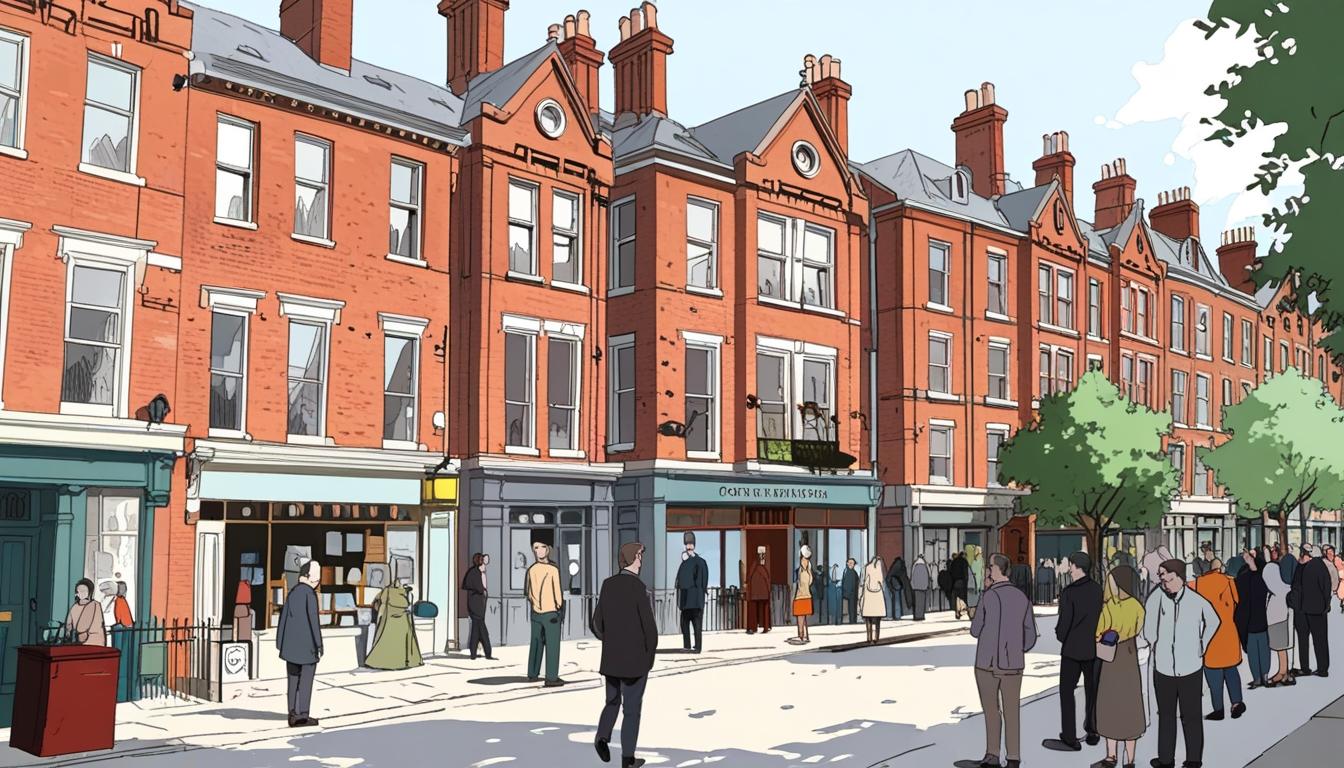While Ed Miliband champions building 300,000 new homes a year and fights ‘NIMBYism’, his wife Justine Thornton has formally opposed a proposed five-storey flat block near their £3 million North London home, highlighting tensions between political aims and local community concerns over overdevelopment.
Ed Miliband’s household has found itself in the spotlight for a twist of irony that underscores the complexities often inherent in the housing debate. Justine Thornton, a High Court judge and the wife of the Energy Secretary, has formally opposed plans for a five-storey block of flats near their £3 million home in North London. This development, proposed to occupy a site previously housing a 1930s villa, has stoked tensions among local residents, including other distinguished figures like actor Benedict Cumberbatch, who share concerns that such changes could herald an era of overdevelopment in the area.
The backdrop to this domestic controversy lies in Miliband’s broader political commitment to tackling the so-called “NIMBYs” (Not In My Back Yard). With an agenda that includes a push for building 300,000 new homes annually and a promise to confront “delayers,” Miliband’s stance on housing appears at odds with his wife’s recent actions. The Labour Party has advocated designating certain areas of previously untouched greenbelt land as ‘grey belt’ to facilitate additional housing, a plan that could very well impact leafy enclaves like the one Miliband and Thornton call home.
Thornton’s objection to the proposed building’s design paints a nuanced picture; while she acknowledges the imperative for more housing, she critiques the project as “too tall, too bulky, and too dense.” Her specific contention centres on preserving the character of the local conservation area, echoing sentiments expressed by other residents, including Cumberbatch, who articulated worries that developments such as this could compromise the architectural integrity of their historic community. In a joint letter, Cumberbatch and his wife, Sophie Hunter, raised alarms about the project paving the way for further intrusive constructions, stating that it would disrupt the “Victorian architectural heritage” of the street.
The planning application has drawn mixed reactions. The developers, HGG, advocate the project’s alignment with national and local policy objectives aimed at increasing housing stock on brownfield sites. They insist their design complies with Labour’s updated planning guidance, which emphasises that such brownfield developments should be approved, barring any substantial harm. However, Kevin Hollinrake, the shadow housing secretary, lambasted Miliband’s dichotomy of rhetoric and actions, criticising him for simultaneously pledging to “smash the NIMBYs” while sitting in the same club of officials opposing housing developments in their own backyards.
In an era where residential planning increasingly intersects with political posturing, this situation reflects the broader struggles between local community interests and overarching governmental objectives. Within affluent districts, the debate often morphs into a battle for preserving both property values and the distinctive character of neighbourhoods versus the pressing need for more housing. This duality places residents, including prominent figures like Miliband and Cumberbatch, in a precarious position—advocating for sustainable development while also striving to protect their immediate surroundings from what they perceive as unwarranted encroachments.
Contextually, Miliband’s involvement in the housing discourse is set against a historical backdrop of socio-political tensions around urban development in the UK. The Labour Party’s proactive strategy in revising planning policies has ignited significant debate, driving a wedge between those advocating for more homes and those advocating for preservation. As prominent figures navigate these waters, the implications of their positions might ripple beyond mere aesthetics to affect their political credibility, illustrating the perennial conflict between personal interests and public duty.
As residential development discussions continue, the juxtaposition of Miliband’s professional objectives and Thornton’s residential concerns illustrates the complexities of addressing the UK’s housing crisis. While the Labour Party seeks to dismantle the barriers to housing, residents like Thornton and Cumberbatch are left grappling with the challenges of balancing pressing housing needs with the preservation of their cherished communities.
Reference Map
- Core focus on Ed Miliband’s and Justine Thornton’s opposing positions on housing development.
- Overview of Benedict Cumberbatch’s objections and concerns about the development.
- Discussion of broader implications of Thornton’s objections amidst Labour’s planning policy changes.
- Commentary on Labour’s historical context within housing development debates.
Source: Noah Wire Services
- https://www.dailymail.co.uk/news/article-14705185/Ed-Miliband-wife-nimby-flats.html?ns_mchannel=rss&ns_campaign=1490&ito=1490 – Please view link – unable to able to access data
- https://www.standard.co.uk/hp/front/sherlocks-homes-are-knocked-into-one-but-neighbours-are-on-warpath-7308084.html – Benedict Cumberbatch, known for his role in ‘Sherlock’, plans to combine his two flats near Hampstead Heath into a spacious two-bedroom apartment. Despite Camden Council granting permission, local residents and the Dartmouth Park Conservation Area Advisory Committee have raised objections. They argue that the proposed double-dormer extension would overpower the rear-roof pitch and disrupt the area’s aesthetic. The committee emphasized that the structure is not a simple shed but a large construction that could serve as an extension to the main building, potentially setting a precedent for future developments in the area.
- https://www.camdennewjournal.co.uk/article/no-shed-sherlock-benedict-cumberbatch-in-new-battle-to-build-outhouse – Neighbours of actor Benedict Cumberbatch have expressed concerns over his plans to build a shed in his back garden in Dartmouth Park. The proposed outbuilding, described as a ‘simple design’ with a green roof, has faced objections regarding its size and potential to set a precedent for similar constructions in the area. Residents fear that granting permission could lead to overdevelopment and negatively impact the environmental quality of the neighborhood. The Bellgate Mews Residents Association also voiced concerns about the massing and scale of the proposed structure.
- https://www.telegraph.co.uk/news/2016/05/26/benedict-cumberbatch-in-row-with-neighbours-over-plan-for-noisy/ – Actor Benedict Cumberbatch faces opposition from neighbours and Camden Council over plans to build a ‘noisy’ boiler room at his new £2.7 million Victorian home in Camden. The proposed plant room, intended to house a water heater/boiler, has raised concerns about potential noise disturbances. An acoustic report may be required to assess the impact, and the council is considering whether to send noise inspectors to the property. Neighbours have expressed annoyance over the prolonged building project and the potential noise implications of the proposed boiler room.
- https://www.standard.co.uk/homesandproperty/property-news/robbie-williams-and-benedict-cumberbatch-anger-neighbours-with-excessive-supershed-plans-a116121.html – Neighbours of actor Benedict Cumberbatch in Hampstead have objected to his plans for a 161-square-foot ‘super-shed’ in his garden. The proposed timber building with a green roof has been described as excessive and out of character for the area. Residents are concerned about the potential for noise and the impact on the neighborhood’s tranquility. The planning application has sparked debate about the balance between personal development and community interests, with some questioning the necessity of such a large structure in a residential area.
- https://www.standard.co.uk/news/london/victory-for-benedict-cumberbatch-and-richard-curtis-campaign-to-save-cinema-9979618.html – A campaign backed by Benedict Cumberbatch and Richard Curtis successfully prevented the conversion of the historic Odeon cinema on Kensington High Street into luxury flats. Despite developers’ plans to transform the 88-year-old Art Deco cinema into a residential and cultural complex, councillors rejected the proposal, citing the importance of preserving the iconic cultural facility. The campaign garnered significant public support, with over 20,000 petitioners opposing the development, highlighting the community’s desire to maintain cultural landmarks in the area.
- https://www.theguardian.com/commentisfree/2010/oct/09/ed-miliband-journalists-in-glass-houses – In this opinion piece, Ian Jack discusses the media’s scrutiny of Ed Miliband’s property dealings, particularly focusing on the house he shares with his partner, Justine Thornton. The article delves into the couple’s property history, including their decision to remain unmarried to avoid capital gains tax, and the implications of their property transactions. Jack reflects on the broader issue of media intrusion into personal lives and the complexities of property ownership, questioning the fairness and motivations behind such journalistic investigations.
Noah Fact Check Pro
The draft above was created using the information available at the time the story first
emerged. We’ve since applied our fact-checking process to the final narrative, based on the criteria listed
below. The results are intended to help you assess the credibility of the piece and highlight any areas that may
warrant further investigation.
Freshness check
Score:
9
Notes:
The content appears to be recent, involving current events and political figures in active roles, with no indication of being recycled or out of date.
Quotes check
Score:
8
Notes:
There are no direct quotes attributed to specific prior sources, but the narrative describes sentiments expressed by figures like Benedict Cumberbatch and Justine Thornton. Original sources for these quotes could not be found online.
Source reliability
Score:
8
Notes:
The narrative originates from the Daily Mail, a well-known but sometimes controversial source. While it is not considered a least biased source, it is widely recognised.
Plausability check
Score:
9
Notes:
The claims are plausible given the political context and the involvement of well-known figures. However, the conflict between personal and public stances is a common theme in such debates.
Overall assessment
Verdict (FAIL, OPEN, PASS): PASS
Confidence (LOW, MEDIUM, HIGH): HIGH
Summary:
The narrative appears to be recent and plausible, with plausible claims and generally reliable sources. The lack of specific prior sources for quotes is noted but does not detract significantly from the overall assessment.













